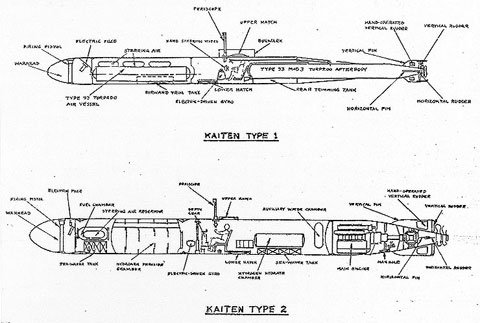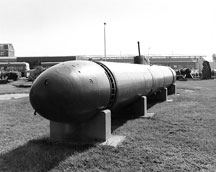| Japanese
Suicide Submarines
By Mike Bennighof, Ph.D.
December 2013
During the Second World War, the accuracy
of torpedoes and air-launched missiles alike
suffered from very primitive guidance systems.
They could deliver huge warheads that devastated
any ship they hit, but actually hit those
targets fairly rarely.

U.S. Navy diagram of Kaiten Type 1 (top) and
Type 2 (bottom).
The Imperial Japanese Navy attempted to solve
that problem by adapting what is still the
most sophisticated computer system on the
planet and likely to remain so for some time:
the human brain. By adding a human pilot to
bombs and torpedoes, they would have a much
better chance of striking their targets. To
some Japanese, this dovetailed with the code
of Bushido, the “Way of the Warrior.”
In its traditionalist form, a practitioner
should view life in retrospect, from the moment
of death.
“Warriors who sacrifice their lives
for the emperor will not die,” wrote
Lieutenant Colonel Sugimoto Goro. “They
will live forever. Truly they should be called
gods and Buddhas for whom there is no life
or death. Where there is absolute loyalty
there is no life or death.”
Suicide as a battlefield tactic has a complicated
place in the Japanese national psyche, one
often difficult to understand from a Western
perspective. As for effectiveness, inserting
a human pilot would seem to have promise of
great success (beyond the morbid aspect) but
in reality obtained very limited results.
Officially, only piloted aircraft were “Kamikazes,”
but they were far from the only Japanese weapon
system to use a suicidal pilot. The navy also
mounted cockpits on torpedoes to create the
Kaiten (“Turning of the Clouds”;
a taijutsu martial arts manuever) suicide
miniature submarine. This was the first Japanese
program to deliberately include suicide as
a planned feature (both American and Japanese
pilots had crashed damaged planes into enemy
ships from the start of the war) but saw combat
after the first Kamikaze aircraft units.

A Kaiten Type 2, captured by U.S. forces. |
Proposed in mid-1943, the Kaiten program
failed to gain approval until early 1944.
The Kaiten Type 1 was simply a Type 93 24-inch
oxygen-fueled torpedo (the famous “Long
Lance”) cut in half, with a new section
inserted in the middle to carry the pilot.
He had a canvas seat (comfort being a secondary
consideration on a one-way mission) and a
small periscope. The Type 93 already had a
massive warhead compared to other nations’
torpedoes; the Kaiten carried one more than
three times its size. If the suicide sub actually
hit its target, it could cause catastrophic
results. The tiny submarine was 48 feet long,
with a variable speed of 12 to 30 knots (below
12 knots, the Kaiten would sink).
Torpedoes are not designed to be tiny submarines;
the Italians called their similar (though
non-suicidal) weapons “pigs”
for their poor handling qualities. The Japanese
vessels appear to have been even harder to
handle, though few pilots came back to make
complaints. A new-model Kaiten appeared anyway,
the Type 2. The Type 2 was seven feet longer,
with a more powerful motor using hydrogran
peroxide and an even larger warhead. Testing
showed it more manueverable than the Type
1. The Type 4 was identical, but with simpler
engineering. Only a few dozen of these types
were made. The bigger Kaiten could make 40
knots, and had more range as well.

A home-made Kaiten found at Truk. Surely
it would have capsized when launched. |
The Type 10 was based on the smaller, 21-inch
Type 92 electric torpedo carried by submarines.
It was even less satisfactory. At a number
of installations, crews appear to have cobbled
together home-made Kaitens, jury-rigging cockpits
on the backs of Long Lance torpedoes. Total
Kaiten production seems to have been about
400 Type I and perhaps two dozen Types 2 and
4, plus an unknown number of field conversions.
Most Kaitens used in action were launched
from submarines. The submarines carried them
in special deck well, usually modified from
their aircraft
hangars. Very few found targets: the first
successful Kaiten attack came in November,
1944, when a submarine-launched Kaiten slipped
into Ulithi Atoll and rammed its charge into
the fleet oiler Mississinewa. In July, 1945
a Kaiten rammed the destroyer escort Underhill,
blowing the ship apart and instantly killing
half her crew.

Indianapolis sets out on her last voyage,
26 July 1945. |
Later that month, the submarine I-58 spotted
the heavy cruiser Indianapolis, travelling
unescorted from Guam to Leyte. The submarine’s
captain, Mochitsuru Hashimoto, sank the target
with conventional torpedoes, but periodically
the claim is made that at least one Kaiten was
involved. Hashimoto testified after the war
that he did not launch the suicide submarines,
because he forgot to issue the order to do so
amid the excitement of finding such a prized
target alone and unguarded.
It’s not known how many Kaiten were
launched unsuccessfully during the last two
years of the war, but the success ratio appears
to have been vanishingly small.
A number of surface ships were modified
to carry Kaiten as well, from overaged destroyers
to cruisers to seaplane carriers. Can the suicide subs strike home? Order
our
game Great Pacific War and find out. |


